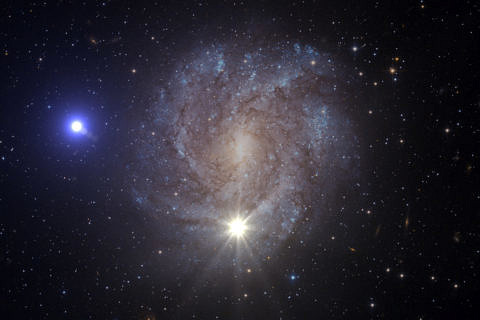The fastest star in the Milky Way

Astronomers identify thermonuclear supernova as cause
Ten years ago, a team of astrophysicists led by researchers at FAU discovered an inconspicuous star in our galaxy, US 708, that turned out to be moving incredibly fast. Based on new observations that the FAU team were involved in, the cause of its extreme speed has now been identified.
One star is moving faster than all the others. Ten years ago, a team of astrophysicists led by researchers at FAU discovered an inconspicuous star in our galaxy, US 708, that turned out to be moving incredibly fast. Based on new observations that the FAU team were involved in, the cause of its extreme speed has now been identified – an explosion, or more specifically, a thermonuclear supernova. The results that have been published in the renowned journal Science contribute to a better understanding of these mysterious explosions (doi: 10.1126/science.1259063).
Travelling at 4,320,000 kilometres per hour, US 708 is around 2000 times faster than a Concorde and approximately four and a half times as fast as our sun. This is a new record, beating the speed of all the stars that have been measured so far by a long way. It is moving so fast that it will leave our galaxy, the Milky Way, never to be seen again. Astronomers currently know of just two dozen other stars among the 100 billion in our galaxy that are travelling at similar speeds. They are usually formed when a binary star comes close to the supermassive black hole in the centre of the Milky Way – and is torn apart. One star falls into the black hole, while its partner is catapulted out of the galaxy, becoming a hypervelocity star.
However, the Erlangen-based researchers were doubtful as to whether US 708 also came from the centre of our galaxy. This was because this theory left one mystery unsolved – why is US 708, unlike other known hypervelocity stars, made of helium? Helium stars are incredibly rare, old stars with masses only half a solar mass. Regular stars like our sun are made mostly of hydrogen.
The most recent observations, in which the FAU team played a considerable role, enabled the researchers to determine how US 708 was created and what caused its incredible speed. The group of researchers with members from FAU’s Dr. Karl Remeis Observatory, the Netherlands, the United Kingdom, the USA and China which was led by Dr. Stephan Geier (European Southern Observatory, Garching, Germany) were able to reconstruct the star’s trajectory. This showed that the star could not have come from the centre of the Milky Way, meaning that the black hole there was ruled out as the catapult.
But what was the event that made US 708 both a hypervelocity star and a helium star? The researchers discovered that US 708 rotates much faster than other known helium stars – an indication that it once had a very close binary partner star whose tidal forces wound it up like a top. Computer simulations were used to give a better picture of the phenomenon.
The binary partner star must have been a highly compact star, only around the size of the earth. Such stars are known as white dwarves. The two stars rotated around a common central point, orbiting faster and faster as they became closer and closer. The white dwarf pulled so much material from it’s partner’s shell that its helium core was exposed and helium then flowed from US 708 to the white dwarf. The distance between them became smaller and smaller while the speed became faster and faster, and more and more helium was transferred to the white dwarf. However, before the white dwarf could devour the other star completely, it exploded as a thermonuclear supernova and was completely destroyed.
Although this explosion was extremely powerful, it was only partially responsible for the high speed at which US 708 is now racing through space. The orbital speeds in the binary star system shortly before the explosion were almost 1000 kilometres per second. As the white dwarf exploded, its gravitational force disappeared suddenly. US 708 maintained its already extreme speed and was accelerated even more by the supernova. Since then it has been travelling through the Milky Way, the fastest star in the galaxy.
The researchers findings show the relationship between helium stars and thermonuclear supernovae for the first time, providing an important contribution to the understanding of what can lead to such gigantic explosions.
Further information:
Prof. Dr. Ulrich Heber
Phone: +49 951 9522214
heber@sternwarte.uni-erlangen.de